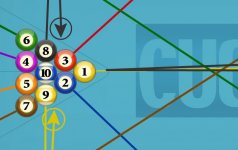Near as I can tell, this is what Corey was doing. Granted, John Schmidt watched it from nearly the same place I did, and he was really struggling to make it work. Take this for what it is- an amateur who's trying to learn from the pros and from those on this board who know more than I do.
The rack
It was similar every time, but the pairs of balls are pretty much interchangable (2,3) (4,5) (6,7) (8,9). I suppose you could choose which side of the table you'd like each ball to end up on, depending on your preferred patterns. For a pro, that's probably a little less important.
The break
He broke from slightly off center and seemed to be trying to hit the 1 ball as squarely as possible, with what appeared to be a hint of draw on the cue ball. The draw should help him make the 2 and 3 in the sides. It also brings the cue ball to the head rail out of the traffic, and back to the middle of the table for position on the 1. It was not a "soft" break like he uses in 9-ball. He was hitting them hard enough to send the 6 and 7 around the table 3 rails, but not much harder than that.
What he was playing (page 2 of the wei table)
He seemed to be clearly playing the 2 and 3 balls in their respective side pockets. Those are the two he made most often. But, as a secondary option, he seemed to be playing the 6 and 7 in their respective corners. By breaking from a few inches off of center, he should send those two balls around the table at slightly different speeds and give them a chance to miss kissing each other near the head rail.
The rest of the rack (page 3 of the wei table)
Racking the 4 and 5 where he did leaves those two balls together and uptable which would be the most natural place for the 2 and 3 balls to head if he doesn't make them in the side, and racking the 8 and 9 where he did leaves a 3 ball cluster near the foot spot for him to finish the out. If the 6 and 7 don't fall, they're likely to end up down at the foot of the table which gives him a couple of balls to work off of to get position on the 8,9,10 cluster.
He rarely made more than a ball or two on the break, but if he ever made all four of the ones he was playing, it would be a throw in rack. Regardless, he left himself similar, and often simple racks to work with. The knowledge seems like something straight out of Joe Tucker's Racking Secrets, but as usual, it seems that Corey has put the time in to figure out how to make it work more often than not.
Now I'm just trying to figure out when I'll have the time to give it a try myself.
The rack
It was similar every time, but the pairs of balls are pretty much interchangable (2,3) (4,5) (6,7) (8,9). I suppose you could choose which side of the table you'd like each ball to end up on, depending on your preferred patterns. For a pro, that's probably a little less important.
The break
He broke from slightly off center and seemed to be trying to hit the 1 ball as squarely as possible, with what appeared to be a hint of draw on the cue ball. The draw should help him make the 2 and 3 in the sides. It also brings the cue ball to the head rail out of the traffic, and back to the middle of the table for position on the 1. It was not a "soft" break like he uses in 9-ball. He was hitting them hard enough to send the 6 and 7 around the table 3 rails, but not much harder than that.
What he was playing (page 2 of the wei table)
He seemed to be clearly playing the 2 and 3 balls in their respective side pockets. Those are the two he made most often. But, as a secondary option, he seemed to be playing the 6 and 7 in their respective corners. By breaking from a few inches off of center, he should send those two balls around the table at slightly different speeds and give them a chance to miss kissing each other near the head rail.
The rest of the rack (page 3 of the wei table)
Racking the 4 and 5 where he did leaves those two balls together and uptable which would be the most natural place for the 2 and 3 balls to head if he doesn't make them in the side, and racking the 8 and 9 where he did leaves a 3 ball cluster near the foot spot for him to finish the out. If the 6 and 7 don't fall, they're likely to end up down at the foot of the table which gives him a couple of balls to work off of to get position on the 8,9,10 cluster.
He rarely made more than a ball or two on the break, but if he ever made all four of the ones he was playing, it would be a throw in rack. Regardless, he left himself similar, and often simple racks to work with. The knowledge seems like something straight out of Joe Tucker's Racking Secrets, but as usual, it seems that Corey has put the time in to figure out how to make it work more often than not.
Now I'm just trying to figure out when I'll have the time to give it a try myself.
